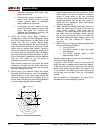
Ridge Tool Company Elyria, Ohio U.S.A www.seektech.com 15
SeekTech SR-60
Figure 22: Tracing Line Showing High Distortion
3. Use the Guidance Arrows, Proximity Number,
Signal Strength, and Tracing Line to guide the
line trace. These pieces of information are
generated from discrete signal characteristics to
help the operator understand the quality of the
locate. An undistorted signal emitted from a line
is strongest directly over that line. (Note: Unlike
the Signal Trace lines, the guidance arrows
require that the user orient the locator so that the
guidance arrows point 90 degrees to the Signal
Trace line. (See
Figure 23).
Note: an undistorted line will also be clear rather
than blurred on the screen, and the sound
accompanying the image will have no “static” in it.
Note: Confidence in the accuracy of a locate can
be increased by maximizing the Proximity Signal
(and/or Signal Strength), balancing the Guidance
Arrows and centering the Tracing line on the screen.
Confirm a locate by testing whether the Measured
Depth reading is stable and reasonable. Agreement
among all these indicators means the probability of
an accurate locate is high.
Figure 23: High Probability Locate
As always, the only way to be certain of the location
of a utility is through visual confirmation by exposing
the utility. The accuracy of position and depth
measurement improves as the SR-60 lower antenna
node is placed closer and closer to the target utility.
Rechecking the Measured Depth and position
periodically during the excavation process can help
avoid damage to a target utility and may identify
additional utility signals that were not noticed prior to
excavation.
When line tracing, it is important to remember that
tees, curves, other conductors in the vicinity, and
nearby masses of metal can add distortion to the
field, requiring closer scrutiny of the data to
determine the true path of the target utility.
Clarifying the situation can be done by assessing
whether the distortion is due to a poor signal that
needs to be improved, a local interference such as a
near-by car, or a tee or turn in the line.
Circling the last location of a clear signal at a
distance of about 20 feet (6.5 m) can clarify if the
distortion is coming from a local turn or tee in the line,
and enable the operator to again pick up the line
nearby.
Always cross check the locate by ensuring that:
• The Tracing Line shows little or no distortion
response (blurriness).
• The Proximity Signal and the Signal strength
maximize when the Tracing Line crosses the
map center.
• The Measured Depth increases appropriately
as the unit is raised vertically and the Tracing
Line remains aligned.
Measured Depth readings should be taken as
estimates and actual depths should be
independently verified by potholing or other
means prior to excavating.
WARNING
Care should be taken to watch for signal
interference that may give inaccurate readings.
The Tracing Line is only representative of the
position of the buried utility if the field is
UNDISTORTED. Do NOT base a locate solely on
the Tracing Line
If the signal is clear, the SR-60 will often show a
straight signal line with very little distortion right up to
a 90-degree tee, show a small amount of distortion
as it follows around the curve, and then show a clear
signal again as it resumes its travel after the tee. It
shows very clearly when the line is turning.
Maximized
Maximized


















